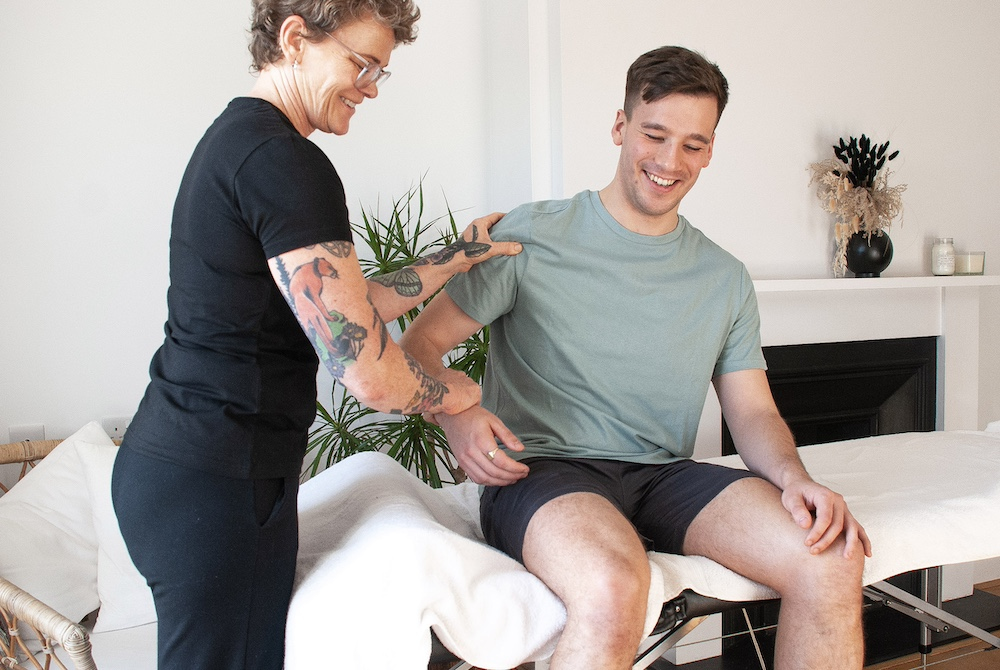Tennis elbow and massage: The ultimate guide
About this post
Get a better understanding of tennis elbow, how to treat it and why it’s so important to get treatment as early as possible.
Posted by
Emily from UrbanTags
- Physiotherapy
- Sports massage
Book a treatment at home
Share
Massage can be highly effective in easing the pain caused by tennis elbow and speeding up recovery. Techniques like cross-fibre friction, myofascial release, and soft tissue release target the affected area.
This helps to improve blood circulation, reduce inflammation, and ease muscle tension. These methods are often part of sports massage, which is recommended for treating this condition.
Regular massage therapy combined with early intervention can prevent the condition from worsening and promote quicker healing.
It isn’t just tennis players that can get tennis elbow
Tennis elbow, or lateral epicondylitis if you’re being fancy, is a pain that affects the areas around your elbow and along your forearm. If left untreated the discomfort can spread all the way down to your wrist, but massage therapy can help speed up recovery while easing the pain.
The pain from tennis elbow is caused by making repetitive movements with your forearm like swinging a racket, hence its name. But unlike what the name suggests, it isn’t just athletes that can suffer from it (tennis players actually only make up 5% of cases).
There are a lot of jobs that ask workers to make repetitive motions with their arms, so they’re just as likely to experience this pain. There are also hobbies that can be the culprit.

Common causes of tennis elbow
The most common causes of tennis elbow include:
Racket sports e.g. tennis, badminton, squash, golf, baseball
Throwing sports e.g. javelin, discus
Weightlifters
Manual labour e.g. plumbers, carpenters, painters, cooks, butchers
Computer users e.g. office and desk workers, gamers
Physical hobbies e.g. playing an instrument, knitting, gardening
Spotting the signs and symptoms of tennis elbow
Whether you’re gripping a racket or a mouse, making repetitive arm movements makes you more likely to develop tennis elbow.
The key thing to look out for is pain coming from outside the elbow. If it’s tennis elbow, the pain will get worse when lifting, bending your arm, gripping objects or twisting your forearm. You might also notice the area feels tender to touch afterwards.
Can massage help tennis elbow?
Yep, massage can be used as a way to reduce the pain caused by tennis elbow and speed up recovery time.
It works by targeting the affected area with techniques like crossfire friction, myofascial release and soft tissue release – this improves blood circulation, reduces inflammation and eases tension. Read on for more details on each of these techniques, and how they can help the pain.
There isn’t a dedicated tennis elbow massage, but a sports massage will do the job
To answer the question ‘is tennis elbow massage a thing?’ the short answer is no, not really. There isn’t a dedicated massage specifically for tennis elbow, but there are specialist techniques that qualified therapists are trained to use to help ease those injuries.
Our go-to massage expert Monica Paslaru, also Founder and Director of Elemental Massage, recommends choosing a sports massage for tennis elbow relief: “the therapist has the skills and knowledge to apply the specialised techniques and adapt to each client’s needs.”
Sports massage also uses a range of techniques that are beneficial in treating tennis elbow, which you can read about below.
The best massage techniques for easing tennis elbow
Myofascial release
This technique focuses on the ‘fascia’, the thin layer of connective tissue around your muscles. Tennis elbow causes this type of muscle to become tight and restricted, but myofascial release uses sustained pressure to release this tension so you can regain movement.
Crossfibre friction
The repetitive movement that leads to tennis elbow can cause scar tissue, but this technique helps to break down these tears to help your tissues repair and heal. This also helps to reduce pain and increase flexibility. To avoid causing even more damage this technique needs to be done with expert precision, so going to a trained therapist is very important.
Soft tissue release
Soft tissue release uses a mixture of stretching movements to help treat issues like tennis elbow. Your pro may ask you to lengthen your arm while they apply pressure, this helps to improve flexibility more effectively than other techniques.

The earlier you book a massage for tennis elbow, the better
Like a lot of conditions, getting treatment as early as possible is key for making a quick recovery. But nipping it in the bud will also stop it from becoming a chronic condition. When tennis elbow is left untreated, it can easily get worse and will take a lot longer to treat – with more intensive treatment techniques needed.
Book a sports massage now to start your road to recovery.
Self-massage tennis elbow exercises you can do at home
Tennis elbow and massage go hand in hand, but if you’re unable to book one regularly there are some at-home techniques you can try in the meantime.
Wrist extension stretch
Slowly bend your wrist backward with the help of your other hand, holding the stretch for 15–30 seconds.
Wrist flexor stretch
Extend your arm and make sure your palm is facing down. With the other hand, pull your fingers towards you – you should feel the stretch in your forearm.
Grip strengthening
Use a stress ball or a soft rubber ball –squeeze and release it repeatedly to strengthen your forearm muscles.
Using a combo of these exercises and regular massage therapy sessions is a great way to speed up tennis elbow recovery and get you back to doing what you love, whether that’s typing away or tackling the tennis court.
For an even better booking experience, download the Urban app and book massage, physio, facials from your phone, to your home.
Make life easier